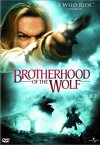BUY THE DVD:
|


|
|
|
SYNOPSIS:
| |
in 18th century france, 2 men are sent by the king to the gevaudan province to investigate the killings of hundreds by a mysterious beast.
|
|
|
MOVIE FACT:
| |
de fronsac travels on a ship aptly named "frŤre loup", french for "brother wolf."
|
|
|
RATING:
|



three out of four possible stars
|
|
|
|
Brotherhood of the Wolf is something of an anomaly in French cinema. Long known as a country that would rather choke on croissants than emulate American filmmaking, it is nothing less than a complete surprise that a group of French filmmakers decided to make a movie like Wolf. It boasts a plethora of different genres and a very large cast of players. One might simply call the film an historical epic, but that would be neglecting the genres of horror, costume drama, Kung-Fu (yes, Kung-Fu), and romance. Even the title of "comedy" might sound appropriate in certain sections of the film, though itís unlikely these sections were meant to be funny.
In what can only be a merging of Eastern, Western, and French cinema, Brotherhood of the Wolf exists as a rather good action-adventure piece which fans of epic/action/martial arts movies might enjoy. Perhaps the filmmakers were attempting to include in their movie every single genre of film in existence in order to attract the largest audience. And surprisingly, in taking a crack at such a challenge, they made but a few middling mistakes. The first of which is obviously the Kung-Fu, Karate, martial arts emphasis on the hand-to-hand combat sequences. While it is very common to include such types of fighting techniques in all manner of modern action films, in a period piece (meaning a film that takes place in a time other than the present), the story seems off kilter in places.
Especially since the person responsible for much of the martial arts is an American Indian living in a time when martial arts hadnít made their way across Asia to Europe (where the story takes place) or to North America. If the story had featured an Asian character instead, the fighting might have seemed more realistic. But given that the film itself is based on an actual myth from French lore, criticizing the action sequences for historical correctness seems like a futile exercise, given that those scenes are actually quite well done, technically. Their length is certainly something that could have benefited from few snips of the editorís scissors.
Some of the scenes that include gun fighting, martial arts, or other assorted fighting techniques extend for just a few minutes too long, allowing the viewer to lose interest in the welfare of the characters. The only activity that remains for a viewer is to focus on the cinematography and scenery of the film when the fight sequences are too long or the scenes themselves become such. It is not recommended that one should concentrate too hard on scenes involving horror and violence (usually the scenes involving the "Wolf" and his prey) because those scenes arenít always pulled off realistically. Like the element of martial arts, the big-budget horror element of the film sometimes elicits a laugh from the audience, rather than a gasp.
A specific element that keeps the viewer from taking the story as serious as it should be taken is the liberal use of slow-motion camera techniques. Employed to heighten the dramatic appeal and effectiveness of the scenes, slow motion comes into play once or twice too often for it to create a suitable impact. But given that slow motion gives the audience ample time to enjoy the scenery of the French countryside, perhaps this element is not so much a wasted one after all. After all, the slow motion actually seems to compliment the melodramatic slant of the story. Certainly the performance of Mark Dacascos (playing one of the men sent to the French countryside to deal with the wolf beast) borders more on the melodramatic than realistic, though the humor from his character is a welcome addition to the weightiness of the story.
And the melodrama in this film isnít an aspect that should be condemned. If anything, the love story between main character, Samuel Le Bihan and …milie Dequenne is realistic and passionate, even if Le Bihanís character isnít the most sympathetic person. After all, he makes visits to brothels for much of the film, effectively cheating on the woman he admires. But character quirks aside, the large cast of the film is, overall, impressive in their performances. Since it is unrealistic to critique the dialogue as this author does not speak French, and that subtitles can sometimes be misleading, the oddities in some of the dialogue might be the fault of the translators more than the screenwriter.
After a few unneeded twists and turns, and a rather epic second half, Brotherhood of the Wolf concludes on an almost inspiring note. Using a combination of slow-motion (perhaps this is a French favorite?), voice over, and sweeping cinematography, the last two or three scenes of the film really raise the bar for the whole piece. No matter if your backside has started to ache because of the somewhat long running time, the film ends on a more than respectable note and concludes what is overall an entertaining film, even if it has a few odd areas. If one were to pin a specific genre on the piece, it would probably be ďhistorical epic.Ē Fans of those types of films will probably be entertained with Brotherhood of the Wolf and non-fans might even get a kick out of such a non-French French film.
Review by Kelsey Wyatt.
| |
|